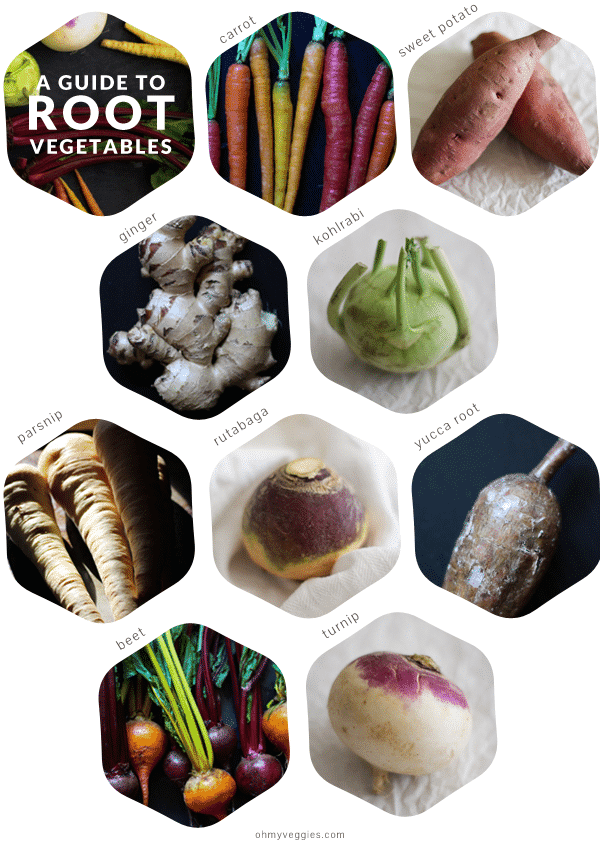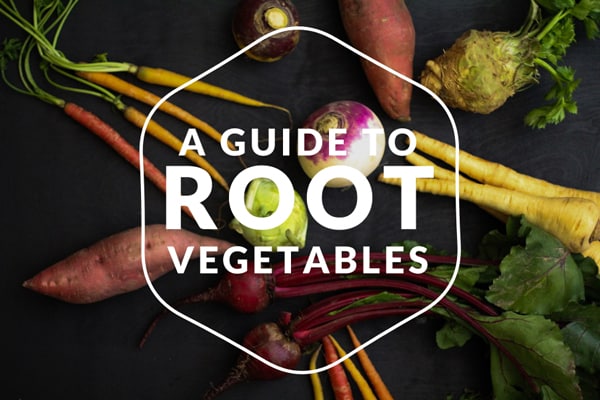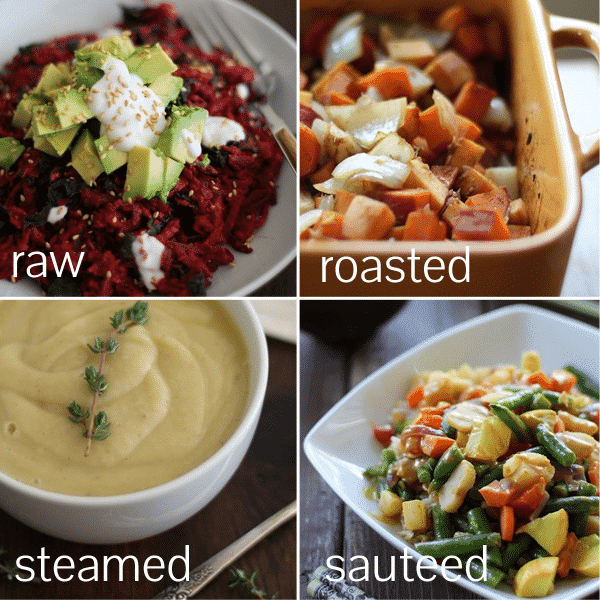Truth: root vegetables can be intimidating. Most of them have thick, strange looking skin and long stems with leaves sprouting out of them. Let’s face it, some of them look like they’re from outer space.
Some root vegetables are given the cold shoulder because they have the reputation of tasting earthy and even bitter. But hold the phone.
This guide to root vegetables can serve as inspiration to embrace those outcast extraterrestrial roots, as they are not only amazing for your health, but they are versatile in the kitchen and absolutely delicious when prepared properly.
Jump to:
The Health Benefits of Root Vegetables
Roots are some of the most nutrient-dense vegetables in the world. While each root contains its own set of health benefits, they share many of the same characteristics.
Yams, beets, parsnips, turnips, rutabagas, carrots, yuca, kohlrabi, onions, garlic, celery root (or celeriac), horseradish, daikon, turmeric, jicama, Jerusalem artichokes, radishes, and ginger are all considered roots.
Because root vegetables grow underground, they absorb a great amount of nutrients from the soil. They are packed with a high concentration of antioxidants, Vitamins C, B, A, and iron, helping to cleanse your system.
They are also filled with slow-burning carbohydrates and fiber, which make you feel full, and help regulate your blood sugar and digestive system.
This factor, plus the high-octane nutrients and low calories, make rot veggies excellent for people who are trying to lose weight, or simply stay healthy.
Root vegetables are disease-fighting, immunity and energy-boosting, and are also extremely versatile in cooking.
What is the Best Season for Root Vegetables?
Most root vegetables are available year round, but their peak season is fall through spring, with the exception of beets, which are best summer through fall. When in-season, roots have a deeper, sweeter flavor and tend to be juicier, but they are one of those plants that seem to stay consistently great all year long.
How Do You Choose Roots?
Selecting good root vegetables is the opposite of selecting good fruit - the harder, the better. They should be smooth and free of gashes or bruises. When choosing roots that come with leafy greens (a bunch of beets, for example), make sure the stems and leaves of the greens are firm and bright.
How Do You Store Root Vegetables?
While you certainly don’t need to have a root cellar to purchase and enjoy root vegetables, they are best stored in a cool, dark, humid room. When storing them in the refrigerator, keep roots in a paper or plastic bag in the crisper. Storing them uncovered causes them to soften and go bad quickly.
What Are the Types of Root Vegetables?
There are almost too many to mention here! These are some of my favorites to cook with:
Sweet Potatoes & Yams
Among the most usable, user-friendly, and palatable, sweet potatoes and yams are great mashed, pureed and made into soup, roasted, and baked into muffins, cookies, pancakes and so much more.
They can be used both in sweet and savory applications and are very well-matched with coconut milk, honey, maple syrup, orange, cinnamon, ginger, pecans, cashews, walnuts, raisins, and curry powder.
Yams are often confused with sweet potatoes, and although they can be used interchangeably, there is a slight difference.
Some of my favorite sweet potato recipes are these brown butter mashed sweet potatoes and this Thai red curry with pineapple and sweet potato.
Beets
Touted as a superfood, beets are among the healthiest foods on the planet. They’re full of beta-carotene and betalains, which are antioxidants and anti-inflammatory.
Beets have an earthy, sweet flavor, and are best when roasted (see how to roast beets here), steamed, or left raw and shredded.
Golden beets are typically slightly sweeter than red beets. I find citrus (particularly oranges or clementines), blueberries, goat cheese, walnuts, ground cumin, cinnamon, and tahini are excellent compliments for beets. This Roasted Beet & Fig Salad is one of my go-to recipes, and this Roasted Beetroot Napoleon is one of my favorite dinner party recipes.
Parsnips
Parsnips have a cinnamon-y flavor and resemble large white carrots (or albino carrots, as I like to call them). They are harder than carrots and have a deeper, warm flavor.
I find parsnips are best used in soups, pureed into a mash, or shredded thinly for parsnip latkes. Parsnips are complimented by nutmeg, cream, and thyme.
Turnips
While turnips are versatile, they are very subtle in flavor, which makes them great for pairing with more strongly flavored vegetables. They are great roasted, sautéed, or included in vegetable stir fry. You can also combine turnips with herbs, or use them in tomato-based chunky soups or creamy pureed soups.
Rutabagas
Similar to turnips, rutabagas are subtle in flavor. They are harder than turnips and taste a bit more earthy. Best when pureed or roasted, rutabagas go well with herbs, particularly dill, as well as lime and Indian spices. They're delicious in these One Pot Lentils and Rice.
Carrots
Crisp and sweet, carrots are perhaps the most popular root vegetable because they are perfect for eating raw. They match well with just about any vegetable in both cooked and raw applications and can be paired with any spice or herb. They're even delicious in baked goods, like these vegan carrot muffins.
Yuca Root
Starchy and subtle in flavor, yuca is often used the same way in cooking as potatoes. It is best when roasted or fried, and it tastes like a potato wedge, although the texture is somewhat stringy. Yuca can be paired with a wide variety of herbs, spices, cheeses, and sauces.
Kohlrabi
Underneath the thick skin and strange tentacles of kohlrabi lies juicy, crisp flesh. (It's truly a weird vegetable, I admit.) Kohlrabi can be cooked or left raw, and it makes delicious oven-baked fries. It can also be made into a mash, pureed into soup, or sliced thinly and added to salads. Combine kohlrabi with any of your favorite spices and herbs. Get some more kohlrabi cooking ideas here.
Ginger
Similar to beets, ginger is a powerhouse root due to its natural antibiotic, anti-inflammatory, and detoxification properties. With a sweet, spicy, yet creamy flavor, ginger can be used in a large variety of foods and drinks.
Ginger is most often used in ethnic food alongside coconut milk and a variety of vegetables, but its uses are virtually endless. Feeling like you’re getting a cold? Drink a kale-ginger detox smoothie and you'll feel like a million bucks!
Onion & Garlic
There is debate as to whether or not onions and garlic are true root vegetables because they are bulbs and do not grow as deep as most of the other roots. Onions and garlic are widely used in cooking, as they both add a great deal of flavor to any dish, both raw and cooked. Both are considered to be heart-healthy veggies, increase circulation, and act as an anti-inflammatory.
How Do You Prepare Root Vegetables?
Roots can be prepared every which way. Experiment and discover what your favorite cooking methods and flavor profiles are!
Raw
Because root vegetables are hard and have an earthy flavor, they are most palatable when cooked. For those who prefer leaving their vegetables raw- carrots, beets, radishes, and jicama are good choices for slicing thinly or grating and tossing with dressing and/or other vegetables and fruit.
Steamed/Boiled
Steaming or boiling root vegetables is a great way of prepping them in order to mash or puree them. Mashed celery root or yams make healthful replacements for mashed potatoes, and any root can blended up into a creamy soup.
Roasted
Roasting any type of vegetable cultivates flavor and texture. Chop up your favorite vegetables, drizzle them with olive oil, sprinkle them with spices, and roast them in the oven.
These simple Spice Roasted Root Vegetables are an easy and delicious dish, and they're a guaranteed way to get the vegetable-averse to eat and enjoy their veggies. You can also thinly slice roots, lay them on a baking sheet, and roast them into root vegetable chips.
Sautéed
Making a vegetable sauté or stir fry is a great way of preparing root vegetables. This is a relatively quick and easy cooking method, and all sorts of flavors can be added to the dish. When cooking with other types of vegetables besides roots, sauté the roots first, as they take longer to cook than other vegetables.
Grilled
Roots can be peeled, thinly sliced, brushed with oil, and grilled along with other summer vegetables. This adds a smoky flavor into the roots and softens their earthiness.
Hopefully those of you who were once on the root vegetable fence are now converted. Good luck on all your root cooking adventures!
More Tasty Resources
If you love these root vegetable ideas, be sure to check out these articles:






Jeanette | Jeanette's Healthy Living says
Love this root vegetable inspiration - so often, root vegetables don't get the respect they deserve. I love using them in stews and roasting them.
Tragic Sandwich says
I've really fallen in love with roasted root vegetables this winter--even though you can't really call it winter where I am. Thanks for more ideas!
Julia says
I'm in the same boat as you. I'm in sunny California, where winter has decided to avoid us altogether this year. But the root veggies have been awesome this year, nonetheless! Glad you like the post 🙂
Tragic Sandwich says
I don't know how I've missed that you're in California--we live in the San Fernando Valley, and we seem to be getting no winter at all.
Joyti says
What a delicious and informative post. I don't think I've had kohlrabi before.
Julia says
Kohlrabi is definitely the root I'm least experienced with, too. I've been thinking about making Kohlrabi slaw for quite some time now. I'll let ya know how it turns out! 🙂
Elisa @ Insalata di Sillabe says
This post is truly amazing and so helpful! I can't wait to venture into the world of root vegetables, which - I have to admit it - I've never really used and/or appreciated much in the culinary field. But things are going to change over here! Thanks so much for these little guide and helpful tips!
xo, Elisa
Julia says
I'm glad you find it helpful, Elisa! Roots definitely help expand your cooking horizons. I hope you have fun experimenting with them!
Laura (Tutti Dolci) says
This is such a great resource for root veggies!
Angie@Angie's Recipes says
A huge fan of root veggies! Thanks for sharing.
Hannah @ CleanEatingVeggieGirl says
And it is official...I can now confirm that the root vegetables are most definitely my favorites!
Dixya @ Food, Pleasure, and Health says
thanks for sharing this. I am always curious about what to do with them esp the kohlrabi
Meg @ Beard and Bonnet says
I LOVE this post and the fact that you are a California girl like myself. Root veggies need more love and you did a brilliant job with this post. Sharing, pinning, and implementing in my own kitchen. Any chance you are close to LA?
Julia says
I live in Tahoe, but I'm going to L.A. in February!! We should meet!!
Holly says
Thanks for the comprehensive overview of so many root vegetables. I am going to try at least 2 new vegetables/preparations on your list this month. I have to start one step at a time and hope to make them part of my usual rotation of foods.
Stephie @ Eat Your Heart Out says
"Most root vegetables are available year round, but their peak season is fall through spring, with the exception of beets, which are always gross." <--I think that's what you meant to type.
Kidding, kidding. (No I'm not.)
But seriously, what an awesome guide! You're so smaht. Teach me to be like you.
Julia says
bahaha! most root vegetables need a lot of love before they become delicious...but when they do, they do, man! 🙂 We'll make roots galore one day soon
Kelly @ Texas Type A Mom says
Root veggies are definitely not my favorites. I've always loved sweet potatoes but it took me well into my adult years before I began to like carrots. Even now, they're not a veggie I could eat plain. And beets are quite possibly my least favorite. Why do they have to be so good for you?!
Julia says
Funny the way that works, isn't it? If only root vegetables tasted like marshmallows, we'd all have super hero strength 😉 You never know - maybe you'll come across a root recipe you can tolerate...it's always good to start mixing them in with a barrage of other veggies in order to mask the flavor. I seriously handed one of my girlfriends shredded raw beet last night and she said, "that tastes like dirt" There's hope I swear! When all else fails, combine beets with chocolate. It works!
Laura says
I recently discovered kohlrabi, but i'm not sure it's in season year round. I get this in my csa box in the spring. But worth seeking out. I have a great salad recipe using it on my blog: http://www.thetableblog.com/2013/06/kohlrabi-apple-and-carrot-salad/
Joanne says
This is such a great guide! I have the hardest time telling the difference between turnips and rutabagas...definitely pulling this up when I'm at the store and can't tell which is which!
marquis @realrawkitchen says
I love this post!! Oh my goodness, it is so full of information and ideas. So many recipes have items listed that aren't very easy to find if you're not quite sure what to look for .. so this is great! Love seeing your posts here at Oh My Veggies!
Dearna @tohercore says
Love this comprehensive wrap up, so useful! I've never cooked with rutabagas, yuka root or kohlrabi before, keen to give it a go though 🙂 Thanks!
Christy@sweetandsavoring says
This is such a great guide. And I think you mentioned almost all of my favorite foods when listing what complements beets! I think I love them raw and shredded best.
Julia Mueller says
I enjoy beets raw, too. I'll run them through the food processor, and add orange zest and juice, ginger, tahini, Indian spices, and eat it with walnuts. I'm amazed at how delicious simple foods like this can be! Glad you like the guide.
Ash-foodfashionparty says
I am totally inspired to go out and grab some.
Well written post. I love root vegetable in every form.
Kira - HealthAble Old Soul says
I appreciate the guide to vegetables that may be not explored as others! By the way, I LOVE the layout for your guide it is beautiful!
EA-The Spicy Rd says
Really fabulous post Julia and Kiersten!!! I am a huge fan of (most) root veggies, not only for their nutritional value and delicious taste, but also because they keep so long 🙂 I just bought some kohlrabi the other day...any favorite recipes to share???
Kasha @ the FarmGirl cooks says
This is a great post? I can't wait to share it with my winter CSA members :). Thanks!
Samantha @FerraroKitchen says
This is such a great post! Per Dr's orders, hubby needs to eat less meat as do I in general. So we are working on incorporating MORE veggies! I also like to tell people to eat the greens of beets. I work at Whole Foods and some of the other cashiers ask if they want their greens cut off..and I run and say no..haha You get double the bang for your buck!
Julia Mueller says
Samantha, I'm so glad you brought up the beet greens thing! I should have included that in the post! I've made salads with roasted beets and beet greens and loved them - Dunno why it skipped my mind to add this fun fact to the guide! I'm happy you enjoy the guide and hope you and your husband enjoy some tasty roots now and forevermore!! 🙂
Joe says
Not important, but a quick note on Kohlrabi, it is in season from spring to fall, and is not, in fact, a root, but a stem. The kohlrabi bulb that we eat grows as an engorged stem near the base of the plant from which the leaves grow out (thus the tentacles remaining after the leaves have been removed).
Sandra says
Lost of Greta info, but you forgot CELERY ROOT!!!
Sandra says
Oops, I meant GREAT info. : )